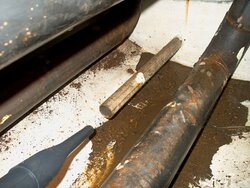Thought this was worth reporting -
Some of us Garn owners had noted large differences in temps between front and back of tank. As much as 30 degrees!! We had wondered about short circuiting because the supply is directly above the return. I think there was even some question as to whether or not there is an extension on the return. See pic. I guess we finally decided that the difference was explained by the fact that the gauge is a little higher than the supply outlet and it was "perfect stratification". I always thought it was kinda funny that my gauge was in water that was 25 degrees hotter than water 5 inches below it. Made me wonder how cold it was at the bottom. Didn't really make sense, to me, knowing my heat load and how well my tank was insulated
Anyway, I have been out of wood for awhile and have been worried about a freeze-up. I had saved back a little wood so I could fire it up if it got real cold. So, this has been a good test of my system and I've been a little tense about it, dashing down the cellar stairs each cold morning to "plug in the pump". I have it temporarily rigged up so I can run only the pump on the Garn-side of the hx. This allowed me to check if it was frozen ( sigh of relief every morning when the water movement is reflected by the gauge on the hx supply) and/or leave it on to circulate to provide freeze protection if needed.. It hasn't been all that cold so I have let the tank just sit there. No fire to make turbulence. No pump running. Just sitting there slowly cooling and stratifying for days and days. Not once have I noticed ANY difference between the gauges. The gauge in my cellar mirrors the gauge on the front of the Garn all of the time. Doesn't that mean there MUST be short circuiting, regardless of the extension pipe on the return port??
Some of us Garn owners had noted large differences in temps between front and back of tank. As much as 30 degrees!! We had wondered about short circuiting because the supply is directly above the return. I think there was even some question as to whether or not there is an extension on the return. See pic. I guess we finally decided that the difference was explained by the fact that the gauge is a little higher than the supply outlet and it was "perfect stratification". I always thought it was kinda funny that my gauge was in water that was 25 degrees hotter than water 5 inches below it. Made me wonder how cold it was at the bottom. Didn't really make sense, to me, knowing my heat load and how well my tank was insulated
Anyway, I have been out of wood for awhile and have been worried about a freeze-up. I had saved back a little wood so I could fire it up if it got real cold. So, this has been a good test of my system and I've been a little tense about it, dashing down the cellar stairs each cold morning to "plug in the pump". I have it temporarily rigged up so I can run only the pump on the Garn-side of the hx. This allowed me to check if it was frozen ( sigh of relief every morning when the water movement is reflected by the gauge on the hx supply) and/or leave it on to circulate to provide freeze protection if needed.. It hasn't been all that cold so I have let the tank just sit there. No fire to make turbulence. No pump running. Just sitting there slowly cooling and stratifying for days and days. Not once have I noticed ANY difference between the gauges. The gauge in my cellar mirrors the gauge on the front of the Garn all of the time. Doesn't that mean there MUST be short circuiting, regardless of the extension pipe on the return port??



